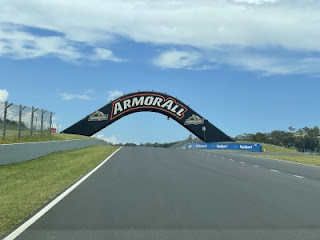On Boxing Day we drove inland towards Bathurst and then on to Cowra for our first overnight stop. As all good tourists do, we took time out in Bathurst to drive the Mount Panorama racing circuit and enjoy its scenic views across the town. No speed limits were broken during our circuit!
We stopped for a picnic lunch on the shores of Lake Carcoar. Picnic lunches have become one of our signature activities on these road trips, both here and overseas. Over the years we’ve built out an impressive “picnic basket” stocked with all manner of cutlery, crockery, and utensils. However, for this trip Garry has taken things to a new level. He’s bought a mobile fridge Eski that plugs into the car during the day and then into a regular household socket at night.
The following morning was spent touring Cowra’s war-themed tourist attractions. During the Second World War Cowra housed a major POW camp. More than 4,000 Axis military personnel and civilians were detained here in a massive complex built on the outskirts of town. Almost half of those interned were Japanese soldiers and officers.
At 1.50 am on the clear moonlit night of August 5, 1944, the largest Prisoner of War breakout in modern military history occurred at Cowra. More than 1000 Japanese prisoners launched a mass 'suicide attack' on their guards.
Armed with crude weapons, four groups each of approximately 300 Japanese threw themselves on to barbed wire fences and into the firing line of Vickers machine guns. Protected only by baseball mitts, blankets, and coats and using their comrades as a human bridge to cross the tangled barbed wire, more than 350 Japanese clawed their way to freedom.
All escapees were captured during the following week. A total of 107 POWs were wounded, and 234 prisoners died along with 5 Australian soldiers. This tragic event has since been immortalised on the camp’s original site with a series of interpretative signs. The site’s most compelling feature is a reproduction of one of the camp’s original guard towers.
Cowra is also famed for its Japanese Garden. It was established as a symbol of peace and reconciliation between Australia and Japan. A commemorative drive connects the Cowra Japanese Garden with the site of the POW Camp and continues to the Australian and Japanese War Cemetery.
The gardens, opened in 1979, cover five hectares of a landscaped hillside, They’re simply stunning. Garry and I spent several relaxing hours exploring its many hidden features.












No comments:
Post a Comment